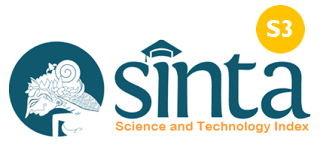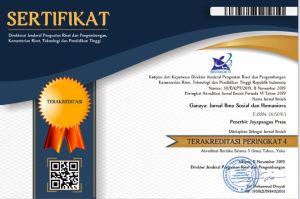Pengembangan Ruang Belajar Virtual Geography Crops Untuk Meningkatkan Kemampuan Berfikir Spasial Peserta Didik SMA
DOI:
https://doi.org/10.37329/cetta.v8i1.3963Keywords:
Virtual Learning Space, Geography Crops, Spatial ThinkingAbstract
Virtual learning spaces that are contextual and interactive have become a primary need in geography education, particularly in en hancing students’ spatial thinking skills. This study focuses on developing a virtual reality-based learning medium, designed as a digital learning space to facilitate the study of plantation resource potential. The purpose of this research is to develop and evaluate the effectiveness of learning medium in improving students’ spatial thinking abilities. The research method employed is the ADDIE model, consisting of five stages (Analysis, Design, Development, Implementation, Evaluation). Data collection was conducted through direct observation. For the analysis of the collected data, the researcher used descriptive statistical analysis techniques. The results indicate that the developed learning medium falls into the category of highly valid. Expert evaluations showed that media expert rated the learning medium at 84.70%, while material expert gave a score of 83.75%. Furthermore, student respondents rated the medium at 84.62%, and teacher respondents provided a score of 94.11%. Based on these four evaluation result, the medium is categorized as highly valid and suitable for use in the learning process. Additionally, the medium has a positive impact on students’ spatial thinking abilities, as evidence by an increase in average student scores at each stage, with a 37.38% improvement in stage 1 and a 7.63% improvement in stage 2. Based on these findings, it can be concluded that the developed medium is highly appropriate for application in learning activities and has a positive effect on enhancing students’ spatial thinking skills.
References
Aliman, M., Halek, D. H., Marni, S., Mike, M., & Florensia, S. (2023). Penerapan Model Problem Based Learning Berbantuan Kahoot Dan Google Earth Untuk Meningkatkan Kemampuan Berpikir Spasial Dan Hasil Belajar Geografi Siswa Sma. GEOGRAPHY: Jurnal Kajian, Penelitian dan Pengembangan Pendidikan, 11(1), 57-71.
Arifin, A. M., Pujiastuti, H., & Sudiana, R. (2020). Pengembangan Media Pembelajaran Stem Dengan Augmented Reality Untuk Meningkatkan Kemampuan Spasial Matematis Siswa. Jurnal Riset Pendidikan Matematika, 7(1), 59-73.
Astawa, I. B. M. (2022). Peningkatan Spatial Thinking Skills Siswa dalam Pembelajaran Geografi melalui Metode Demonstrasi Berpendekatan Kontekstual. Journal of Education Action Research, 6(2), 242-251.
Atta, G., Abdelsattar, A., Elfiky, D., Zahran, M., Farag, M., & Slim, S. O. (2022). Virtual Reality in Space Technology Education. Education Sciences, 12(12), 890.
Azzahra, R., Muryani, C., & Tjahjono, G. A. (2023). Development Of Gis-Based Learning Multimedia to Improve Spatial Thinking Ability of Social Students in High School. GeoEco, 9(2), 242-255.
Bond, C. E., & Cawood, A. J. (2021). A Role for Virtual Outcrop Models In Blended Learning-Improved 3D Thinking And Positive Perceptions Of Learning. Geoscience Communication, 4(2), 233-244.
Carmona, R., Felices, M. L. P., Morenilla, A. J., & Mora, H. M. (2018). Virtual Reality Learning Activities for Multimedia Students to Enhance Spatial Ability. Sustainability, 10(4), 1074.
Conesa, J., Mula, F. J., Bartlett, K. A., Naya, F., & Contero, M. (2023). The Influence of Immersive and Collaborative Virtual Environments in Improving Spatial Skills. Applied Sciences, 13(14), 8426.
Febrianto, A. D., Purwanto, P., & Irawan, L. Y. (2021). Pengaruh Penggunaan Media Webgis Inarisk Terhadap Kemampuan Berpikir Spasial Siswa Pada Materi Mitigasi Dan Adaptasi Bencana. Jurnal Pendidikan Geografi, 26(2), 73-84.
Guzsvinecz, T., Mihálykó, É. O., Perge, E., & Lányi, C. S. (2020). Analyzing The Spatial Skills Of University Students With A Virtual Reality Application Using A Desktop Display and the Gear VR. Acta Polytechnica Hungarica, 17(2), 35-56.
Hall, T., & Cherry, N. M. (2022). Negotiating Applied and Critical Perspectives Within the Geography Curriculum. Journal of Geography in Higher Education, 46(4).
Khoirina, A., & Adriyani, Z. (2024). Inovasi Pembelajaran Era Digital: Pengembangan Teknologi Augmented Reality di Sekolah Dasar. Didaktika: Jurnal Kependidikan, 13(001), 31-42.
Lestari, L. (2022). The Influence of Learning Media And Teacher’s Pedagogic Competence On Learning Effectiveness. JKP: Jurnal Kepemimpinan Pendidikan, 4(2), 620-631.
Medani, Z. P., Suharto, Y., Taryana, D., & Sumarmi, S. (2022). Pengaruh Model Guided Discovery Learning Berbantuan Google My Maps Terhadap Kemampuan Berpikir Spasial Siswa SMAN 1 Singosari. Jurnal Integrasi dan Harmoni Inovatif Ilmu-Ilmu Sosial (JIHI3S), 2(6), 534-547.
Meduri, N. R. H., Firdaus, R., & Fitriawan, H. (2022). Efektifitas Aplikasi Website Dalam Pembelajaran Untuk Meningkatkan Minat Belajar Peserta Didik. Akademika, 11(02), 283-294.
Mubai, A., Giatman, M., Usmeldi, R. F., Effendi, H., Muskhir, M., & Karudin, A. (2020). Meta Analysis: The Effectiveness of Learning Media Based on Virtual Simulation in Technical Vocational Education. Padang: Atlantis Press.
Nurcahyo, A. D., & Winanti, E. T. (2021). Pengaruh Model Problem Based Learning Terintegrasi Pendekatan Induktif Terhadap Kemampuan Berpikir Spasial Dan Pengetahuan Siswa Pada Materi Mitigasi Bencana. Jurnal Pendidikan Geografi, 26(1), 41-47.
Putra, V. K., Fatih, M., & Niam, F. (2024). Pengembangan Media Booklet Berbasis Sets Materi Sumber Energi Untuk Meningkatkan Kemampuan Berpikir Kritis Siswa Sekolah Dasar. JURNAL PENDIDIKAN DASAR PERKHASA: Jurnal Penelitian Pendidikan Dasar, 10(1), 29-39.
Putri, E. S., Harjanti, D. T., & Buwono, S. (2024). Analysis of Interests Students in Learning Geography in Class XI IIS in MAN 1 Sintang. Jurnal Pendidikan Sosiologi dan Humaniora, 15(1), 148-156.
Rachmawati, D. N., Kurnia, I., & Laila, A. (2023). Multimedia Interaktif Berbasis Articulate Storyline 3 Sebagai Alternatif Media Pembelajaran Materi Karakteristik Geografis Indonesia di Sekolah Dasar. Jurnal Pemikiran dan Pengembangan Sekolah Dasar (JP2SD), 11(1), 106-121.
Rahayu, S. T., Handoyo, B., & Rosyida, F. (2022). Peningkatan Kemampuan Berpikir Spasial Siswa Melalui Penerapan Project Based Learning Dengan Menggunakan Platform Google Classroom. Jurnal Integrasi dan Harmoni Inovatif Ilmu-Ilmu Sosial (JIHI3S), 2(1), 68-80.
Resti, N., Ridwan, R., Palupy, R. T., & Riandi, R. (2024). Inovasi Media Pembelajaran Menggunakan AR (Augmented Reality) pada Materi Sistem Pencernaan: (Learning Media Innovation Using Augmented Reality on Digestive System Material). BIODIK, 10(2), 238-248.
Silmi, T. A., & Hamid, A. (2023). Urgensi Penggunaan Media Pembelajaran Berbasis Teknologi. Inspiratif Pendidikan, 12(1), 69-77.
Safadel, P., & White, D. (2020). Effectiveness of Computer-Generated Virtual Reality (VR) in Learning and Teaching Environments with Spatial Frameworks. Applied Sciences, 10(16), 5438.
Said, S. (2023). Jurnal PenKoMi: Kajian Pendidikan & Ekonomi. Jurnal PenKoMi: Kajian Pendidikan dan Ekonomi, 6(2).
Santoso, A. (2022). Pengaruh Media Pembelajaran Google Earth Terhadap Kemampuan Berpikir Spasial Siswa SMA. Geodika: Jurnal Kajian Ilmu dan Pendidikan Geografi, 6(2), 152-162.
Sari, R. M., Urfan, F., Ridhwan, R., Herliza, M., Dani, F. R., & Sembiring, T. B. (2023). 3D Street Story Map Learning Media for High School Student’s Spatial Thinking Ability. Journal for Lesson and Learning Studies, 6(3), 379-389.
Syofniati, S. (2019). Implementasi Pendekatan Kontekstual Dalam Pembelajaran Geografi (Studi Deskriptif Pada Siswa Kelas Xi Ips 4 SMA Negeri 4 Pekanbaru). JPG: (Jurnal Pendidikan Geografi), 6(1).
Togatorop, F., Banjarnahor, D. N., & Saragih, D. Y. (2022). Sosialisasi Pengaruh Teknologi dalam Pendidikan di Era Globalisasi di Sekolah Dasar (SD) Swasta HKI 3 Pematangsiantar: Socialization of the Effect of Technology in Education in The Era of Globalization in Private Elementary Schools (SD) HKI 3 Pematangsiantar. Jurnal Pengabdian Masyarakat Indonesia, 1(2), 68-76.
Wijayanto, P. A., Rizal, M. F., Subekti, E. A. K. E., & Novianti, T. A. (2018). Pentingnya Pengembangan Geography Virtual Laboratory (Geo V-Lab) sebagai Media Pembelajaran Litosfer. JP (Jurnal Pendidikan): Teori dan Praktik, 3(2), 119-125.
Yuan, X., Zhang, C., Li, J., Niu, J., Li, X., & Shi, X. (2024). A Deep Learning-Based Teaching Design for High School Geography Units: Taking the Example of Landforms of the Humanistic Education Edition. Journal of Contemporary Educational Research, 8(2), 176-182.
Yulianti, S. D., Arini, R. E., & Fildansyah, R. (2023). Merangkul Teknologi: Mengintegrasikan Realitas Virtual dalam Pengalaman Pembelajaran. Jurnal Pendidikan West Science, 1(06), 350-356.
Downloads
Published
How to Cite
Issue
Section
License
Copyright (c) 2025 Nadhifan Fawwazian Azzukhruf, Yusuf Suharto

This work is licensed under a Creative Commons Attribution-ShareAlike 4.0 International License.
An author who publishes in the Cetta : Jurnal Ilmu Pendidikan agrees to the following terms:
- Author retains the copyright and grants the journal the right of first publication of the work simultaneously licensed under the Creative Commons Attribution-ShareAlike 4.0 License that allows others to share the work with an acknowledgement of the work's authorship and initial publication in this journal
- Author is able to enter into separate, additional contractual arrangements for the non-exclusive distribution of the journal's published version of the work (e.g., post it to an institutional repository or publish it in a book) with the acknowledgement of its initial publication in this journal.
- Author is permitted and encouraged to post his/her work online (e.g., in institutional repositories or on their website) prior to and during the submission process, as it can lead to productive exchanges, as well as earlier and greater citation of the published work (See The Effect of Open Access).
Read more about the Creative Commons Attribution-ShareAlike 4.0 Licence here: https://creativecommons.org/licenses/by-sa/4.0/.





